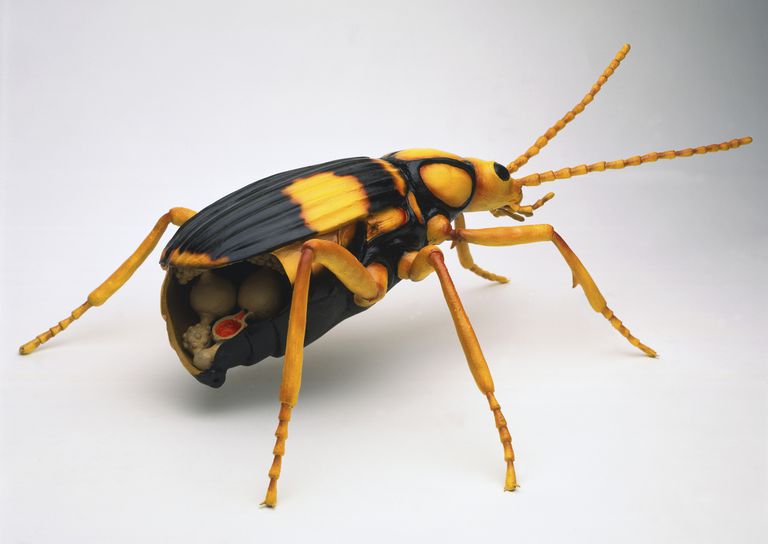The bombardier beetle can spray its hot brew of toxic chemicals even after bring swallowed, to force a predator into vomiting it back out.
放屁甲虫甚至可以在被捕食者吞食后,继续喷射热的有毒化学物质,迫使捕食者将其吐出。
播音\撰文:卡伦·霍普金(Karen Hopkin)
翻译:张朵儿
审校:郭晓
If you’re a fan of nature shows, you’ve probably heard of the bombardier beetle. When disturbed, this weaponized insect can spray a boiling hot jet of noxious chemicals from its hind end—a response that even the hungriest predators find highly off-putting.
如果你是自然节目的粉丝,那你可能听说过放屁甲虫(bombardier beetle)。每当它被其他生物惊扰的时候,这个全副武装的小虫会从身体末端喷射出一股沸腾的有毒化学物质——这个反应使哪怕再饥饿的捕食者都不愿接近。
But what if that predator is so stealthy and quick that the beetle doesn’t have time to deploy its signature defense before it gets ‘et? Turns out, the explosion is also effective when detonated from the inside. We know this because a new study shows that the bombardier beetles can use their chemical weapons to escape from the belly of the toad that ate them. They accomplish this Jonah-like feat by using their chemical cocktail to encourage the amphibian to barf them back up. The finding is served up in the journal Biology Letters. [Shinji Sugiura and Takuya Sato, Successful escape of bombardier beetles from predator digestive systems]
但是,如果捕食者过于隐秘和敏捷以至于甲虫没有时间施展其特有的防御手段就被吃掉了怎么办?事实是,即使在捕食者体内,这种爆炸般的毒气喷射也是有效果的。我们这样说是因为,最新的研究表明,放屁甲虫会利用他们的化学武器从捕食它们的蟾蜍的胃里逃脱。甲虫通过自身产生的化学鸡尾酒对两栖动物实行催吐,从而实现约拿先知般的死里逃生。这项研究发表在《生物学快报》(Biology Letters)杂志上。
Researchers collected 37 beetles and 37 toads from a forest in Central Japan. Some of the toads, those of the species Bufo japonicas, share their territory with the bombardier beetles. Others, the Bufo torrenticola, inhabit the nearby streams and don’t normally encounter these feisty bugs.
研究人员从日本中部的森林里收集了37只甲虫和37只蟾蜍。一部分属于Bufo japonicas种类的蟾蜍和放屁甲虫生活在共同领域,其他生活在溪流附近的Bufo torrenticola蟾蜍,并不经常会遇到这些活跃的虫子。
Back in the lab, the researchers paired off their collected specimens and each toad was allowed to capture and swallow a single beetle. And then came the fireworks. As the authors note in their paper: “an explosion was audible inside each toad.” Which means that somewhere along the alimentary canal, the beetles dropped their bombs.
回到实验室,研究人员把收集来的样品配对,让每只蟾蜍捕食一只甲虫。然后,就到了精彩的部分。作者在论文中写道:“我们能在每只蟾蜍的体内听到爆炸声。”这就意味着,在消化道的某个地方,甲虫们扔下了它们的炸弹。
What happened next depended on the participants. About 35 percent of the japonicas toads, who presumably were familiar with the beetles, spit the critters back up. While 58 percent of the stream toads gave the researchers valuable feedback, literally—they upchucked, too.
接下来发生的事情完全由蟾蜍决定。大约35%的japonicas蟾蜍把甲虫吐了出来,而这些蟾蜍据推测是对甲虫比较熟悉的。然而58%生活在溪边的蟾蜍给了研究人员有价值的反馈:事实上,它们也把甲虫吐了出来。
As for the bugs, the larger ones were more likely to make it back out. The lucky ones escaped in under 15 minutes. And those less fortunate were in there up to an hour and a half. And though they emerged covered in mucus, all 16 vomited beetles returned alive and were able to walk away. Fifteen of them were still kicking two weeks later. And one survived to tell his tale for another a year and a half.
至于虫子,越大的越可能有机会从蟾蜍体内逃出来。幸运的几只能在15分钟以内逃出来。而不太幸的几只会在那儿呆上长达一个半小时。即使出来的时候身上沾满了粘液,但被吐出来的16只甲虫全都是活着的并且能够自行离开。其中15只在两周后都还精力旺盛,还有一只甚至又活了一年半。
And it was largely their emetic emissions that saved them. Bugs who were prodded into depleting their chemical arsenals before they got eaten were never seen—or heard from—again. The authors note that “no toads died as a result of swallowing beetles.” But after their contribution to science, they probably avoided hot sauce.(? did not get it)
主要还是带有催吐效果的排射物救了它们。在被吃掉之前受到刺激而耗尽化学武器的虫子,再也没有出现或者发出声音。作者还写道“没有蟾蜍因为吞食甲虫而死”。但是,在完成对科学的贡献之后,它们可能会躲着辣椒酱了。

 京公网安备11010502039775号
京公网安备11010502039775号  京公网安备11010502039775号
京公网安备11010502039775号 
















